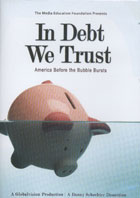
In Debt We Trust: America Before the Bubble Bursts 2006
Distributed by Media Education Foundation, 60 Masonic St., Northampton, MA 01060; 800-897-0089
Produced by Danny Schechter (an Altacliff Film, a Globalvision production)
Directed by Danny Schechter
DVD , color and b&w, 52 min.
Sr. High - Adult
Business, Economics, Political Science
Date Entered: 06/11/2008
Reviewed by Scott Smith, University Libraries, UNLV, Las Vegas, NVWritten, produced, and directed by Emmy award winning television producer (CNN and ABC’s 20/20) and independent filmmaker Danny Schechter, In Debt We Trust is a documentary that explores the causes and consequences of consumer debt in the United States. Schechter, acting as an engaging “everyman,” is the on-camera presence tying the introduction and ten individual segments together. The titles of the segments (Credit Card Crusader, How the Companies Operate, Marketing Machine, How Did We Get Into This Mess, Nation Transformed, Crunch is Coming, Bankruptcy Blues, Politics of Credit, Predators at Work, What Must be Done) provide a fairly intuitive description of the message: there is a consumer debt crisis driven by a collusion between business and government to continue and expand debt in order to enrich the creditors.
There are no counter points of view provided by, say, the Wall Street Journal or representatives of the Chamber of Commerce. What is presented is a frightening portrait of debt out of control, with skilled filmmaking (superb technical quality with just enough humor provided by Schechter and the judicious use of the 1960 b& educational film, The Wise Use of Credit, starring Mr. Money), and an effective mix of interviews with experts (such as Rochester Institute of Technology professor Robert Manning, the author of Credit Card Nation) who proffer very explicit opinions about the danger of the present economic situation and segments reporting on activists (such as ACORN’s Mildred Brown, who works to reform legislation that impacts low- and moderate- income families) and individuals who themselves have been adversely affected by consumer debt. The documentary is eerily prescient when addressing the devastating potential of a widespread failure of over-extended consumers to maintain their mortgage payments—the high-risk mortgage loan bubble that has since burst.
Beginning and ending with footage from a Virginia church that has incorporated individual financial solvency as part of its mission (including debt revival meetings), with stops along the way that include segments on the rapacity of credit card companies’ pursuit of college students, the high consumer cost of “payday loan” and rent-to-own services, and the impact of lobbyists from the credit card and financial sectors on legislation dealing with consumer debt and bankruptcy, In Debt We Trust is an informative and engaging, albeit one-sided, examination of consumer debt in the United States.
Recommended for individual or class viewing for high school through college students. While the film as a whole is directed toward economics, business, and political science courses at the college level (or for social studies or current events classes at the high school level), individual segments also could be useful in generating discussion in other subject areas. For example, several segments touch on the prevalence of particularly predatory activities (e.g., “payday loans”, rent-to-own, check-cashing, tax-rebate) on poor and minority areas and might be appropriate for use in sociology, urban affairs, or multicultural courses.